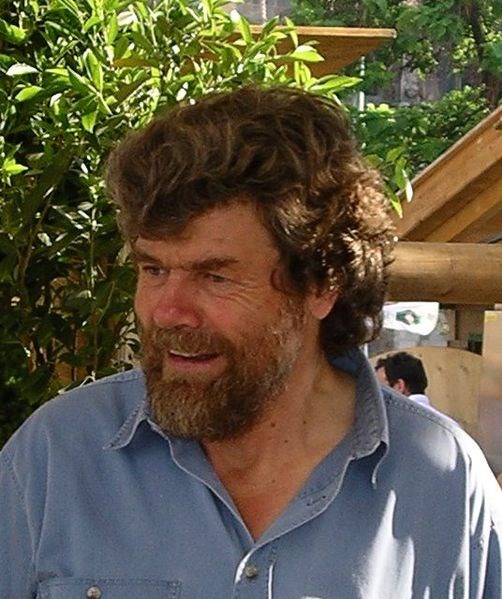 |
| Reinhold Messner (commons.wikimedia.org) |
Can you imagine climbing Everest without oxygen? How about doing it solo. This may seem like madness to people like you and me, but to climber Reinhold Messner, it’s reality. He was born way back in 1944 in an Italian city named Vilinoss. At the age of five he began to climb the mellower routes around the area. Today at age 64 he is one of the most famous and successful climbers in history. Read on to learn more.
Messner began climbing some more difficult routes at age 15 when he took a month long trip through the Italian Dolomites. Between 1964 and 1977 he went on a climbing extravaganza climbing 8000 meter peaks in Bhutan, Tibet, India, Switzerland, Nepal, Pakistan, Persia and East Africa. Finally in 1978 he reached the peak of his climbing career. He soloed Everest without supplemented oxygen. That incredible feat set the bar extremely high for mountaineers and he became an icon in his sport.
Later that year he jumped right onto Kilimanjaro and Nanga Parbat. Over the next two decades his focus slowly turned from high altitude climbs to traverses across mountain ranges and even entire countries. Between 1980 and 2004 he traversed Bhutan, The Altai Mountains, Antarctica, Greenland, southern Georgia, eastern Tibet and finally the Gobi desert. In 2005 he set up the Messner Mountain Museum for anyone interested in mountaineering and high altitude climbing. In the last decade Messner has written over a dozen books involving his climbs and his lifestyle. In 2005 he also was a member of the European Parliament.
Today Reinhold Messner is a role model for younger climbers and a still active member of the mountaineering community, but he has seen troubles of his own. In 1986 his brother Günther was killed in an avalanche near the base camp on Nanga Parbat. It was a huge blow to Messner, but in later years he overcame that event and soloed the peak several times. Another thing that surprised me about Messner is his climbing style, which some climbers refer to as "alpine style climbing." This style of climbing includes many variations of the supported climbs you often hear about. On many of his climbs Messner would start from the bottom of the mountain and carry all of his gear up to natural bivouacs, which serve as temporary camps. During the actual climb no route is prepared and supplemented oxygen is not used. This style of climbing leads to cleaner but far more difficult adventures. In my opinion this style shows much more respect for the mountain and the people who climb them.
Reinhold Messner is a hero to me for many reasons. Today he represents climbing and adventuring not for fame or fortune but simply for the love of the mountains and the determination to conquer them. He also is willing to set aside his own goals to help another climber (Lhotse in 1989 and Ruwenzori in 1994). With no doubt Reinhold Messner will continue to inspire generations of climbers for many decades ahead. He is a hero.
Page created on 5/19/2008 12:00:00 AM
Last edited 1/5/2017 10:27:48 PM
- All Fourteen 8,000:ers
- Free Spirit : A climbers life
- My Quest for Yeti : Confronting the Himalayas Deepest Mystery
- The Crystal Horizon : Everest-The First Solo Ascent
- Annapurna: 50 Years of Expeditions in the Death Zone
- Antarctica : Both Heaven and Hell
- Everest : Expedition to the Ultimate
- Hermann Buhl : Climbing Without Compromise
- Moving Mountains
- The Big Walls
- The Second Death of George Mallory
- Big Walls : History, Routes, Experiences
- The Challenge
- K2
- Monte Rosa
- The Seventh Grade
- Solo : Nanga Parbat
